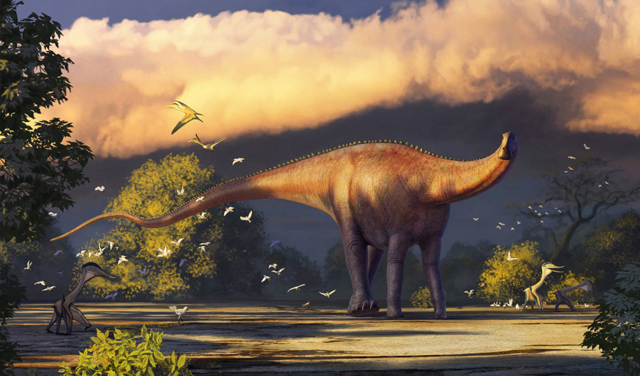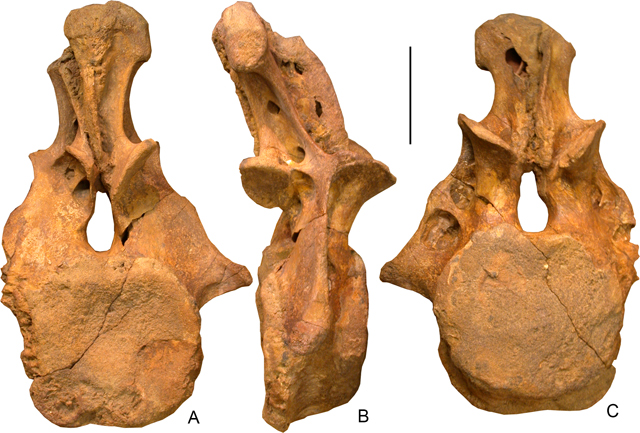An open-access paper has recently been published in the on-line academic journal PLOS One announcing the discovery of a new species of rebbachisaurid sauropod. The newly described dinosaur named Dzharatitanis kingi is the first member of the Rebbachisauridae family to have been found in Asia. Rebbachisaurids are known from Europe, Africa South America and possibly North America. They are related to diplodocids such as Brontosaurus and Apatosaurus and most palaeontologists group them in the Diplodocoidea superfamily along with the Diplodocidae and the rare and enigmatic Dicraeosauridae dinosaurs.

Described from a Single Fossil Bone
Described from a single, well-preserved tail bone from the base of the tail (anterior caudal vertebra), this herbivore is estimated to have been around 15 to 20 metres in size. The fossil bone was found in 1997, by David Ward and one of the authors of the scientific paper, Hans-Dieter Sues, during the Uzbekistan/Russian/British/American/Canadian exhibition to map and document Late Cretaceous Dzharakuduk escarpment outcrops associated with the Bissekty Formation in the Kyzylkum Desert of Uzbekistan.
Dzharatitanis is (as far as Everything Dinosaur team members are aware), the first sauropod to have been formally described from the Bissekty Formation.
The strata associated with the fossil find are believed to be around 90 million years of age (Turonian stage of the Late Cretaceous). D. kingi represents one of the geologically youngest known rebbachisaurids.

“Dzharakuduk titan”
The genus name is derived from the Dzharakuduk escarpment and translates as “Dzharakuduk titan”, whereas the species name honours the late Dr Christopher King who did much to map and document the geology of the Cretaceous-aged strata of central Asia.
Numerous “pencil-shaped” teeth along with isolated bones indicate the presence of sauropods within the Bissekty Formation however, D. kingi is the first member of the Sauropoda to be described. The caudal vertebrae of these types of dinosaur are very diagnostic. Their shape and characteristics help palaeontologists to identity related genera and this single fossil bone, believed to represent the first bone of the tail was sufficient to merit the erection of a new dinosaur species.
The sauropods from the Bissekty Formation now comprise at least two taxa, the rebbachisaurid Dzharatitanis kingi and an indeterminate and as yet unnamed titanosaur.
The scientific paper: “First rebbachisaurid sauropod dinosaur from Asia” by Alexander Averianov and Hans-Dieter Sues published in PLOS One.
The Everything Dinosaur website: Everything Dinosaur.






Leave A Comment